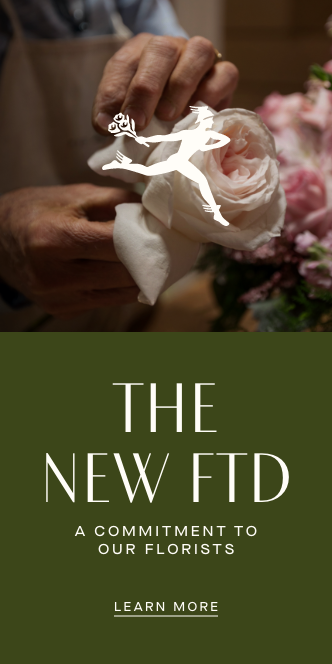
Extending The Enjoyment
Customers fall in love with your floral designs as much as the beauty of the blooms. But prized arrangements can fade days sooner than they should from improper care. Maximized vase life is essential to consumer satisfaction, but keeping cut flowers in peak condition requires keen attention along every step of a flower’s journey.
Four keys to long-lasting flowers, from field to vase.
The more you educate yourself, your team and your customers on optimal flower care, the longer your designs will last, the more joy you’ll spread and the more referrals you’ll receive. Here are four keys for the entire floral supply chain to ensure the freshest flowers for consumers.
1. Sanitation And Disease Control
Pathogens are everywhere. Bacteria can accumulate on flower stems or in water any- where along the supply chain. Unchecked, microbes multiply and block flowers’ water and nutrient uptake, which accelerates their decline. Additionally, farmers dip or spray roses to prevent fungal Botrytis damage. Vigilant cleanliness from the growers’ fields to the retail coolers is critical to preventing flower deterioration before it starts.
From the flower fields to the flower shops, supply-chain partners strive to control and prevent contamination. But it’s more than just buckets that need scrubbing. Clippers, benches, shelves, buckets and any surfaces that come in contact with flowers should be cleaned regularly. Ideally, flower storage buckets should be cleaned between each use but certainly between each shift).
WHAT YOU CAN DO: Create a strict sanitation protocol, and train your team to use it. Sanitize all contact surfaces frequently. Bleach will work, but other commercial products can provide longer-lasting disinfecting benefits.
PRO TIP: Keep a spray bottle and rag handy on each design bench for quick tool touch-ups between projects.
2. Hydration And Nutrition
Flowers are 85 percent to 90 percent water. Once stems are cut, flowers lose their natural source of food and water, which keeps them fresh and perky. Air and debris can clog stems, shortening flower life. Flowers need a steady stream of water and nutrients flowing to their cells to maintain peak condition.
Flower growers time their harvests and treat stems to maximize hydration before shipping. A no-sugar or low-sugar solution hydrates stems but limits flower development through transport and storage, until you are ready to “activate” them in designs.
WHAT YOU CAN DO: Unbox deliveries quickly, and recut stems, if necessary. Place stems in flower buckets with a properly proportioned solution of water and flower food. Dosage matters! Fifty percent of all fresh flower food is improperly dosed. Proper mixing can substantially increase flower life
PRO TIP: Improper hydration can show in ways besides petal and leaf droop. Inspect foliage for signs of dryness or decline that may become evident before affecting the flower itself.
3. Ethylene Control
At least 30 percent of postharvest flower losses come from ethylene damage. This invisible gas is concentrated around ripening produce; cigarette smoke; and fuel sources (trucks, equipment and planes). Ethylene exposure causes wilting, discoloration, irregular opening and shattering of flower blooms. Many flowers are highly susceptible to ethylene damage, including carnations, Gypsophila, sunflowers, lilies, roses, tulips and more.
Careful attention to avoid and block ethylene damage is critical and now possible with commercial ethylene-shielding products. But the insidious damage can take days to appear, sometimes not becoming apparent until flowers reach retail, or worse, the end consumers.
WHAT YOU CAN DO: How can you know if your flowers were treated with an ethylene shield at the flower farm? Ask your suppliers! It’s your assurance that your floral designs will remain in top condition, avoiding flower loss and customer disappointment.
PRO TIP: Stressed and decaying flowers give off even more ethylene, which can further accelerate flower decline. Take proper care of healthy stems, and promptly remove any from inventory that are deteriorating.
4. Temperature Management
Temperature throttles flower lifespan. The industry’s cold supply chain slows a flower’s metabolism into a hibernation-like state, keeping them dormant until you are ready to design. But it’s a team effort. For temperate flowers, every degree above 38 F shortens flower life, with temperatures above 41 F shortening flower life as much as 65 percent to 75 percent, depending on the duration. Tropical flowers should be held at temperatures above 55 F.
WHAT YOU CAN DO: Maintain the cold chain! Unpack flower boxes and cool the flowers promptly. Check cooler temperatures regularly, and keep cooler doors closed as much as possible. Use temperature to your advantage to manipulate bloom opening for optimal timing in your designs.
PRO TIP: To open flowers for event work, remove stems from the cooler, and place them into lukewarm flower nutrient solution (properly proportioned, of course!) the day before design. Blooms will be open to occupy the ideal space in your creations.

Extending the vase life of cut flowers at the consumer level doesn’t end with you. Educate consumers on their role in feeding and nurturing their flowers. Every order is an opportunity to cultivate repeat buyers. Offer advice on proper flower care, and provide flower- food packets with every order. Certain flowers like roses, Dahlia, lilies, sunflowers and yarrow last from 50 percent to 300 percent longer with flower food! Flower food is your best insurance policy for long vase life, customer delight and repeat business.
Farm to vase, FloraLife offers a one-stop shop to maximize the longevity of flowers. From hospital-grade sanitizers to optimal hydration, nutrition and ethylene protection products, we follow the flowers. Our goal is to help you exceed consumer expectations and get more repeat business. FloraLife: Experts in cut-flower care.
Related Articles
Related
What to Do with Broken Flowers
Tips to make the best of problematic product. By Jill Brooke Many of us at the dawn of our careers, while attending floral design school, were told the following in very stern terms: You shall NOT complain when flowers break because your relationship with your...
Crowning Glory: Explore the Art of Headpieces
Floral design and text by Julia Prokhorova, AIFD, CFD, TMF | Wild Veggie Bouquet | Corpus Christi, Texas Photos by Cora Johnson | Cora Johnson Photography | Corpus Christi, Texas There are so many reasons to wear a...
Fashion and Floral Design
Exploring the beauty of wearing blooms By Molly Lucille The flower industry has found endless paths to activation as collaboration between art mediums becomes part of the flower world’s zeitgeist. From runways to editorial shoots, high fashion has started to...






















